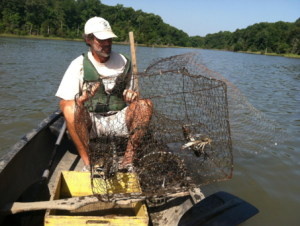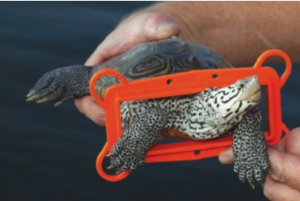Wetlands bog man. Lake Matoaka arsonist. Dr. Pepper enthusiast. Dr. Randy Chambers has acquired several identities throughout his time at the College of William and Mary as a professor of biology and director of the Keck Environmental Field Lab. He is likely most known for his dedication toward diamondback terrapins, a species of turtle.
However, Chambers has not always been the turtle devotee that he is today. He describes his association with terrapin research as “very much a chance thing. I wasn’t ever thinking about working on turtles at all. I just stumbled upon it, or it stumbled upon me.”
Before joining the College’s faculty, Chambers taught in Connecticut at Fairfield University. Back then, he primarily directed his attention toward wetland biogeochemistry research. Chambers was first introduced to terrapins through a postal worker that contacted him about sampling turtles. Together they caught, weighed, marked, and identified turtles within the Long Island Sound. Chambers recalls one day when he asked her why they were doing all this: “And she says ‘Oh no reason, I just like turtles.’ Apparently that’s what people do; they like turtles.”
Eventually, the postal worker quit sampling, and gave her nets to Chambers. These nets were brought over to the College when he was hired as the director of the Keck Environmental Field Lab.
We flash forward to 2001, when an undergraduate comes to Dr. Chambers about using some data for a class project. Chambers provided the data he obtained while sampling terrapins at the Long Island Sound, and new data on terrapins from the Chesapeake Bay region. Surprisingly, the statistical analysis found that diamondback terrapins sampled from the Chesapeake Bay were significantly larger than the diamondback terrapins from the Long Island Sound. Chambers postulated that the differences in size could be traced to commercial crab fishing, since the practice was introduced to the Chesapeake region in the mid-20th century.

A brief lesson on crab fishing: many commercial watermen use large box-like traps called “crab pots.” The crab pots allow crabs to crawl through a funnel-like entry way, and the funnel design of the entry way reduces the frequency of crab-exit (crabs are not that smart). Even though crabs are the intended targets for this kind of trap, many other creatures may end up in the trap as a “bycatch,” namely certain fish and turtles (they aren’t that smart either). Tragically, turtles suffer the most from these traps. Once caught in these below-water crab pots, they no longer are capable of obtaining air from the surface. If left in these pots long enough, they will eventually drown. Even more tragically, turtles are very social creatures, so they often flock to a trapped turtle, very much to their own demise.
These observations of size difference and terrapin behavior led to the hypothesis that the smaller terrapins in the Chesapeake Bay are more likely to become trapped and drown in crab pots, leaving only larger terrapin survivors. Chambers explains, “these crab traps are imposing so much mortality on turtles that it is actually leading to some selection for size. And size is one of the stronger phenotypes that can be selected on a genotypic basis.” In short, Chambers suggested that only larger terrapins survive long enough to reproduce, and their offspring genetically inherit the larger-size trait.
Chambers sampled a cohort of diamondback terrapins collected before 1940 (the advent of commercial fishing throughout the Chesapeake Bay) by the Smithsonian Institute to compare current terrapins to the terrapins alive before the advent of commercial crab fishing. This data confirmed that Chesapeake Bay terrapins were the same size as current terrapins from Long Island Sound, suggesting that commercial crab fishing has has contributed to enough terrapin death to cause a morphological change to terrapins.
Since this discovery, Chambers has devoted much of his time towards preventing terrapin mortality in crab traps. Recently he has been investigating the success of bycatch reduction devices (BRDs). BRDs are simple rectangular pieces of plastic that are installed onto the funnels of crab pots. The size and shape of the plastic prevents diamondback terrapins from entering the crab pot, while allowing crabs to still easily enter the trap. With BRDs, traps are able to exclude terrapins and catch crabs.
So is terrapin mortality problem solved?
Turns out it is not so simple. These BRD cost less than a dollar, which doesn’t at first seem expensive. But to a commercial fisherman with hundreds of crab pots, BRDs can become a pricey accessory. Additionally, many commercial fishermen are suspicious of how effectively pots with BRDs catch crabs.
Nevertheless, many states have pushed forward legislation on crab pots regulation in order to sustain terrapin populations. Maryland, Delaware, New Jersey, and New York have enacted state-wide regulations on crab pots, requiring BRD or approved alternative BRD installment for commercial and/or recreational crab fishing. Virginia, however, has been relatively slow to issue crab pot regulations. Chambers commented with an injured tone on Virginia’s legislation, “it’s just a little bit slower to do these things.”
One aspect of Chamber’s research on terrapins has been investigating the effects of BRDs in order to help make potential recommendations to legislators on crab pot regulations.
Recently, Chambers has analyzed the influence color potentially has on terrapin and crab catch. Being that both terrapins and crabs are highly visual creatures, Chambers aims to investigate whether certain colors influence crab and terrapin attraction toward or deterrence from these traps. In 2014, while monitoring turtles exposed to differently colored crab pot entrances (without BRDs), Chambers found that terrapins did not show preference or avoidance toward any certain color.

Courtesy of National Aquarium Waterblog
However, a field study involving crab pots with differently colored BRDs revealed that there was no significant difference between the number of legal male crabs caught in traps without BRDs and the traps with red BRDs. This study suggests that red BRDs do not reduce the crab catch, and potentially crabs are attracted to the color red. This result seems even more plausible considering that female crab claws are red when they are reproductively active.
This past summer Chambers has continued his work on colored BRDs, focusing now on the comparison between crab pots without BRDs and crab pots with red BRDs. His experiment found no difference in the number of legal crabs caught between the two pot types. This study did find that crabs caught in traps with red BRDs were smaller than crabs caught in the no-BRD trap, but by just 1 millimeter.
Chambers also spent last summer analyzing video footage of crabs interacting with crab pots. It appears that more crabs enter crab traps without BRDs, but are more likely to exit that crab trap. Crab pots with red BRDs, on the other hand, limit the frequency of crabs entering the traps, but also prevent more crabs from exiting traps. Although these two crab traps elicit different responses from crabs, they both result in the same net effect.
Currently, Chambers is preparing to investigate how crab catch is influenced by BRDs with color duality: painted red on the front and white on the back. Chambers aims to optimize crab pot efficiency of capture with these two-toned BRDs, hypothesizing the crabs will be attracted to the red entrance side of the BRD and deterred from or indifferent to the white exit side. This study was inspired from a prospective College student who attended a presentation given by Chambers. After explaining the apparent attraction crabs have for the color red, a student asked “Why don’t you paint the front of it red and the back of it white.” Now, due to the insightfulness of one student, Chambers has directed his research toward the influence of multi-colored BRDs.
Toward the end of my interview with Chambers I mentioned how much it appears that his work on terrapins is serendipitous, as Chambers credits much of his research to the postal worker from Long Island Sound, the undergraduate student with a statistics assignment, and the high school student with the minor observation. Chamber jokes, “Just imagine what I could have done if I was a good researcher.”
Jokes aside, I find that the somewhat coincidental trajectory of Chambers work with terrapins resonates with many other notable discoveries. Renowned scientist Alexander Fleming discovered penicillin by chance on a petri dish after returning from a summer getaway. Coca-Cola was an accidental concoction of coca leaves, cola nuts, and carbonated water. Velcro was designed by a Swiss electrical engineer who was inspired by cockleburs on his dog’s fur. Chamber’s unexpected turn toward terrapins demonstrates how random, unintentional moments are not only a byproduct of the scientific process, but can be a key driver of scientific discovery.

